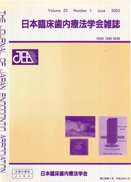16 巻, 2 号
選択された号の論文の11件中1~11を表示しています
- |<
- <
- 1
- >
- >|
総説
-
1995 年 16 巻 2 号 p. 159-167
発行日: 1995年
公開日: 2019/06/30
PDF形式でダウンロード (9920K) -
1995 年 16 巻 2 号 p. 168-174
発行日: 1995年
公開日: 2019/06/30
PDF形式でダウンロード (7275K) -
1995 年 16 巻 2 号 p. 175-190
発行日: 1995年
公開日: 2019/06/30
PDF形式でダウンロード (14742K) -
1995 年 16 巻 2 号 p. 191-200
発行日: 1995年
公開日: 2019/06/30
PDF形式でダウンロード (7455K)
原著
-
1995 年 16 巻 2 号 p. 201-206
発行日: 1995年
公開日: 2019/06/30
PDF形式でダウンロード (3690K) -
1995 年 16 巻 2 号 p. 207-210
発行日: 1995年
公開日: 2019/06/30
PDF形式でダウンロード (2971K) -
1995 年 16 巻 2 号 p. 211-217
発行日: 1995年
公開日: 2019/06/30
PDF形式でダウンロード (6834K) -
1995 年 16 巻 2 号 p. 218-222
発行日: 1995年
公開日: 2019/06/30
PDF形式でダウンロード (3102K)
ケースレポート
-
1995 年 16 巻 2 号 p. 254-260
発行日: 1995年
公開日: 2019/06/30
PDF形式でダウンロード (4240K) -
1995 年 16 巻 2 号 p. 261-264
発行日: 1995年
公開日: 2019/06/30
PDF形式でダウンロード (983K) -
1995 年 16 巻 2 号 p. 265-268
発行日: 1995年
公開日: 2019/06/30
PDF形式でダウンロード (1564K)
- |<
- <
- 1
- >
- >|
